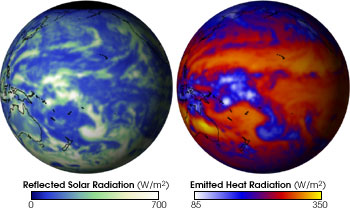Geotimes

Untitled Document

Web Extra
Thursday, May 5, 2005
Heat imbalance portends problems
 Results
from a new assessment show that Earth is absorbing more energy than it releases
into space. With implications for climate change, researchers say the study
points to future warming with consequences for ice sheets and sea level.
Results
from a new assessment show that Earth is absorbing more energy than it releases
into space. With implications for climate change, researchers say the study
points to future warming with consequences for ice sheets and sea level.
Satellite measurements from CERES show how much solar radiation Earth reflected
(left) and how much heat it emitted (right) on January 1, 2002. The bright spots
are thick clouds that both reflect heat from the sun and trap it on Earth's
surface. New research shows that more heat is being trapped than emitted, unbalancing
the planet's heat ledger. Image courtesy of NASA.
A team of scientists led by James Hansen of the NASA Goddard Institute for Space
Studies (GISS) has run the center's global climate model through a variety of
scenarios, using observations of ocean heat changes over the past decade to
check their conclusions. Published in Science Express on April 28, they
show that the planet takes up around 0.85 watts per square meter more than it
gives off, absorbing heat from the sun that is then trapped by greenhouse gases,
aerosols and other such "forcings," while only a small portion of
the heat escapes. The imbalance in the planet's heat equation is a "smoking
gun" for increased global warming, the researchers say.
Using climate forcings of human-made greenhouse gases and aerosols, along with
other factors, the model shows that the future imbalance to the climate system
will likely come from a lag in ocean temperature shifts. How long it takes to
transfer heat from the ocean's surface to its deep layers will determine how
fast the climate changes.
"The large energy imbalance that we have found implies that global temperature
responds slowly to forcing agents, with much of the response lagging several
decades behind," Hansen said in a press release. The current feedback to
the system "clearly is positive and will lead to additional warming."
The researchers suggest that with additional warming still "in the pipeline,"
policy-makers should find ways to pull the amount of greenhouse gases and aerosols
out of the atmosphere that would match the imbalance in heat absorption in order
to avoid future warming — essentially trying to prevent trapping more heat
to counterbalance the heat that will be released from the oceans later.
The team also forecasts accelerated ice-sheet melting, which could lead to a
10-year sea-level rise of 1.6 centimeters. Continued measurements of ocean heat
storage are necessary, they write, to confirm whether their model is correct
regarding both its sensitivity to climate forcing and the amount of climate
forcing calculated to be occurring.
This study is one of many tests of major climate models from research groups
around the world, which are being prepared for the fourth assessment report
for the Intergovernmental Panel on Climate Change, says Gerald Meehl of the
National Center for Atmospheric Research (NCAR) in Boulder, Colo. Meehl calls
the results "consistent" with past and current tests of global climate
models that have coupled ocean-atmosphere dynamics, including that which he
published with co-workers on the NCAR model in Science on March 15. "Even
if the concentrations of greenhouse gases in the atmosphere had been stabilized
in the year 2000, we are already committed to further global warming of about
another half degree," they wrote, and to substantial sea-level rise, "caused
by thermal expansion [of the oceans] by the end of the 21st century."
Still, the implications from Hansen's team's results are different. "The
ice sheets are what [they are] most concerned about," Meehl says. "Nobody
quite knows these ice sheet mechanisms." Meehl points to the breakup of
the Larsen B Ice Shelf in the Antarctic, which "shattered in a matter of
weeks," he says. "Then the glaciers surged — and are still surging,"
according to research published in the Geophysical Research Letters last
month, signifying increasing temperatures and potentially increasing glacial
inputs into the ocean.
"We're using [the models] as tools to understand what's going on,"
Meehl says. But despite potential problems with those tools, "if you are
getting the oceans right, you are probably getting the atmosphere right."
Naomi Lubick
Links:
NASA
press release and link to animation
James
Hansen's Web site with links to publications
Back to top
Untitled Document

 Results
from a new assessment show that Earth is absorbing more energy than it releases
into space. With implications for climate change, researchers say the study
points to future warming with consequences for ice sheets and sea level.
Results
from a new assessment show that Earth is absorbing more energy than it releases
into space. With implications for climate change, researchers say the study
points to future warming with consequences for ice sheets and sea level. 
